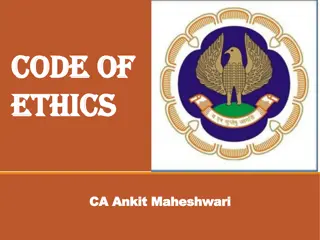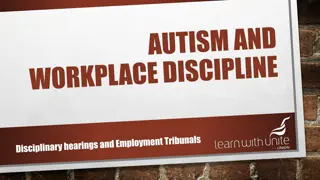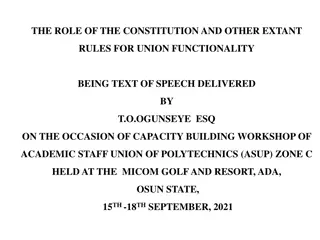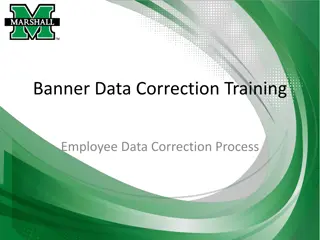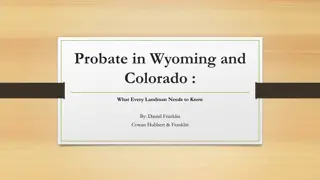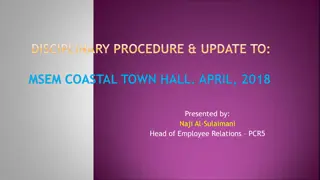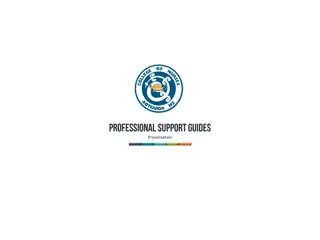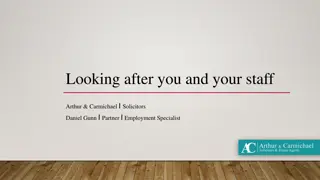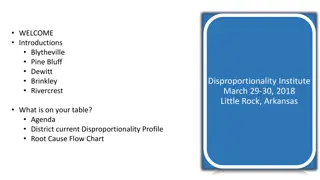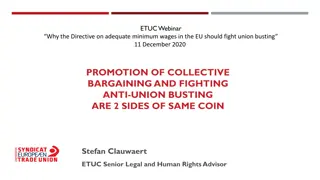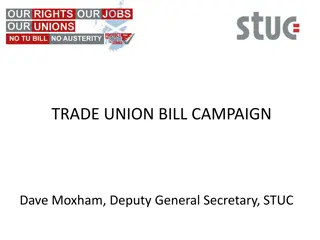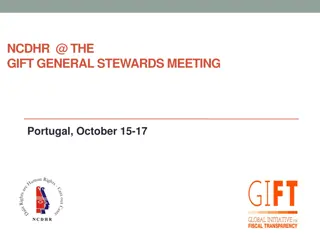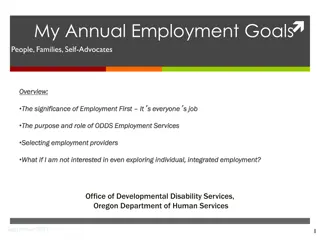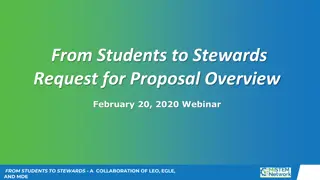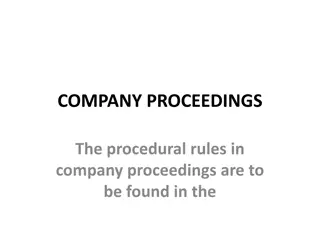Federal Employment Disciplinary Proceedings and Union Stewards Overview
This comprehensive guide covers common issues faced by union stewards in federal employment disciplinary proceedings, including proposed actions, Collective Bargaining Agreement violations, EEO complaints, and disciplinary actions for federal and NAF employees. It outlines the process for misconduct and unacceptable performance, emphasizing the importance of due process and union representation. Essential tips are provided for employees facing disciplinary actions, ensuring fair treatment and proper defense strategies.
- Federal employment
- Disciplinary proceedings
- Union stewards
- Collective Bargaining Agreement
- Misconduct
Download Presentation

Please find below an Image/Link to download the presentation.
The content on the website is provided AS IS for your information and personal use only. It may not be sold, licensed, or shared on other websites without obtaining consent from the author. Download presentation by click this link. If you encounter any issues during the download, it is possible that the publisher has removed the file from their server.
E N D
Presentation Transcript
Federal Employment Disciplinary Proceedings Bonney, Allenberg, O Reilly, & Eddy, P.C. 4854 Haygood Rd., Suite 200 Virginia Beach, VA 23455 Tel: (757) 460-3477 Fax: (757) 460-5387 Website: http://baofedlaw.com We are also on Facebook!
Common BUE Issues Presented to Union Stewards Disciplinary Actions Usually consists of a proposed disciplinary action and the right to reply to the proposal Violations of the Collective Bargaining Agreement Including violations of law or regulations that have been incorporated into the CBA EEO Complaints Only applies to complaints of unlawful discrimination
Disciplinary Actions For most* non-probationary federal employees, before effecting disciplinary action against the employee, the Agency MUST provide the employee with due process, i.e., a Notice of Proposed Disciplinary Action and an Opportunity to Reply to the Proposal. Employees will often turn to their Union reps for assistance with their reply to a proposed disciplinary action! Disciplinary actions will always be categorized as either: 1. misconduct or 2. unacceptable performance *NAF employees are different. For NAF employees, disciplinary process is usually spelled out in agency disciplinary instructions. However, many agencies disciplinary instructions for NAF employees mirror the process for other employees, including proposal and opportunity to reply.
Discipline: Performance Proposed performance-based actions usually involve the employee first being issued an unacceptable performance appraisal and placed on a Performance Improvement Plan (PIP). Oftentimes, if the employee really is experiencing a performance deficiency, there may be a medical condition at play negatively affecting the employee s performance. Ask the employee questions to find out if a reasonable accommodation argument could be made in the reply.
Discipline: Misconduct Misconduct is the most frequent issue in disciplinary actions. The specific misconduct being alleged should be explicitly set forth in the proposal notice, which should state the Charge or Charges, and any and all Specifications (specific instances of alleged misconduct, including the 4 W s : who, what, when, where). If this information is not included in the proposal notice, ask for it in writing! If the information is still not provided and employee does not know what the specifications are referring to, explain in the reply that the employee and Union were not provided sufficient information to notify the employee of what specific misconduct is being alleged. Sometimes, I don t know what the proposal is talking about can be a perfectly valid defense!
Discipline: Understanding What Happened When an employee brings a proposed disciplinary action to her Union representative, it is important to read the proposal and ask the employee questions about the facts alleged. Even if the employee admits that the incident occurred as alleged, there may be mitigating circumstances calling for a lesser penalty.
Discipline: Understanding What Happened Ask the Employee: Did the incident occur as alleged? If so: Why did you do it? What are the surrounding circumstances? Did anyone else do the same thing? Were they disciplined? Did the incident occur differently than alleged? If so: What really happened? Are there any witnesses? (name, job title, contact information) If the employee identifies witnesses, ask her to get letters (signed and dated) from the witnesses confirming what happened. Are there any documents that would support your version of the facts? If the employee identifies documents, ask her to provide the Union with those documents or, if the employee does not have the documents in her possession, file a 7114(b) Request for Information to get the documents from the Agency.
Discipline: Understanding What Happened When representing an employee in her reply to a proposed disciplinary action, ALWAYS do three things upon receipt of the proposal: 1. REQUEST TO REPLY ORALLY AND IN WRITING! 2. REQUEST AN EXTENSION! Especially with proposed removals, even if you don t need an extension, extending the proposal period extends the amount of time the employee is still in a paid status with the Agency. 3. REQUEST ANY AND ALL MATERIALS RELIED UPON IN PROPOSING THE ACTION! Even if you think the employee already has any documents associated with the allegations, there are always other documents, such as the agency s disciplinary instructions and table of penalties, that can be requested and used in the reply. All of these requests should be in WRITING!
Discipline: Preparing the Written Reply A written reply does not need to be long, eloquent, or include citations to a million cases. The written reply should include a summary of the charge and any specifications, along with a specific explanation of why the charge/specifications are wrong and why the penalty is too severe. If the Agency did not provide sufficient evidence to allow the employee to respond to the specific allegations, don t play a guessing game. Instead, explain in the reply that the employee was not provided sufficient evidence for the employee to be able to respond to the specific allegations. If applicable, make suggestions to the deciding official about other witnesses they should contact and/or documents they should seek in order to get the full story before making a decision on the proposed action.
Discipline: Preparing the Oral Reply The oral reply can simply be used to highlight aspects of the written reply. If you are not comfortable speaking off the cuff, you can even read directly from the written reply in presenting the oral reply. The oral reply is a good opportunity to make suggestions as to alternatives to formal discipline or settlement proposals that the employee may be willing to accept. For example: Employee is facing proposed removal but is only 6 months away from reaching minimum retirement age, and was planning on retiring at her MRA. Oral reply can be used to explain that the employee would be agreeable to retiring at her MRA if the agency agrees to hold the removal action in abeyance until her retirement.
Discipline: Mitigating the Penalty Oral and written replies can often be used to successfully mitigate the ultimate penalty imposed. Even if the employee admits to misconduct, it is important to reply in order to highlight any mitigating circumstances that may call for a reduction in the penalty.
Discipline: Mitigation (Douglas Factors) ALWAYS discuss the applicable Douglas Factors in replying to proposed action. The Douglas Factors: 1. The nature and seriousness of the offense, and its relation to the employee's duties, position, and responsibilities, including whether the offense was intentional or technical or inadvertent, or was committed maliciously or for gain, or was frequently repeated; 2. The employee's job level and type of employment, including supervisory or fiduciary role, contacts with the public, and prominence of the position; 3. The employee's past disciplinary record; 4. The employee's past work record, including length of service, performance on the job, ability to get along with fellow workers, and dependability;
Discipline: Mitigation (Douglas Factors cont d) 5. The effect of the offense upon the employee's ability to perform at a satisfactory level and its effect upon supervisors' confidence in the employee's ability to perform assigned duties; 6. Consistency of the penalty with those imposed upon other employees for the same or similar offenses; 7. Consistency of the penalty with any applicable agency table of penalties; 8. The notoriety of the offense or its impact upon the reputation of the agency;
Discipline: Mitigation (Douglas Factors cont d) 9. The clarity with which the employee was on notice of any rules that were violated in committing the offense, or had been warned about the conduct in question; 10. Potential for the employee's rehabilitation; 11. Mitigating circumstances surrounding the offense such as unusual job tensions, personality problems; mental impairment; harassment; or bad faith, malice or provocation on the part of others involved in the matter; and 12. The adequacy and effectiveness of alternative sanctions to deter such conduct in the future. Douglas v. Veterans Administration,5 MSPR 280 (1981).
Discipline: Receipt of Decision If a decision is issued imposing disciplinary action, the employee is left to decide what to do next: MSPB appeal? (15+ days suspension, removal, demotion) (Specific to Title 5 Employees) (Not for NAF) Refer employee to Union lawyers Grievance? Normally available for disciplinary actions in which the MSPB would not have jurisdiction check your CBA! EEO complaint? If the Employee has either an MSPB or grievance right, do NOT file it as an EEO complaint. EEO Complaints should be considered the option of LAST RESORT! Disability retirement? Comes up a lot in performance-based actions Employee can file for disability retirement and still litigate case in another forum. (Ex. GS/WG employee removed for medical inability but could have continued doing her job if the Agency had accommodated her. Employee can file for disability retirement but still file MSPB appeal to appeal the termination.)
MSPBAppeal For Eligible BUEs Once a decision on a proposed disciplinary action is issued, the employee has 30 calendar days from the effective date of the disciplinary action to file an appeal to the MSPB. As soon as the decision is issued, if you have not done so already, contact the Union attorneys and provide us with the applicable documentation (Notice of proposed disciplinary action, Supporting documents, Reply, Decision on proposed disciplinary action) An MSPB appeal is filed with the Regional MSPB office with jurisdiction over your area. A map showing the jurisdictions for the Regional MSPB offices can be found on the MSPB website (www.mspb.gov).
Merit Systems Protection Board (MSPB) Overview What can be appealed to the MSPB? Appeals of adverse actions (suspensions of 15 days or more, including indefinite suspensions; removals; demotions; involuntary retirement) Individual Right of Action (IRA) appeals concerning whistleblower retaliation Appeals of disability retirement denials Who is covered? Available to most tenured Title 5 GS (white collar) and WG (blue collar) federal government employees who have been issued an adverse action NOT available to NAF employees NOT available to probationary employees (with very limited exceptions) When does an MSPB Appeal Get Filed? File petition for appeal within 30 calendar days of the EFFECTIVE DATE of the adverse action


